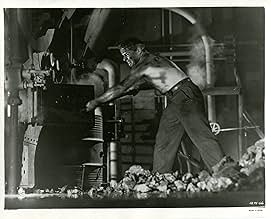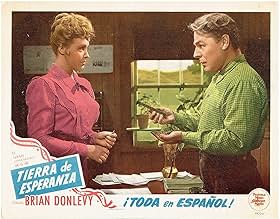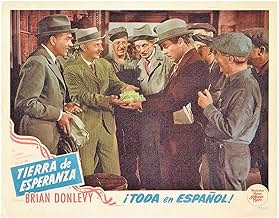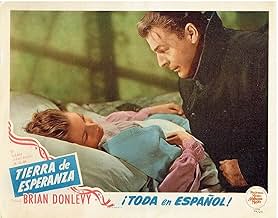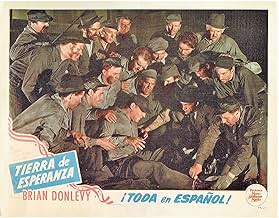IMDb RATING
6.7/10
641
YOUR RATING
Stefan Dangos, an immigrant, starts working in iron mines and steel mills. Through hard work, he rises through the ranks, eventually becoming a successful American industrialist.Stefan Dangos, an immigrant, starts working in iron mines and steel mills. Through hard work, he rises through the ranks, eventually becoming a successful American industrialist.Stefan Dangos, an immigrant, starts working in iron mines and steel mills. Through hard work, he rises through the ranks, eventually becoming a successful American industrialist.
- Awards
- 2 wins total
Stephen McNally
- Teddy Roosevelt Dangos
- (as Horace McNally)
- …
Ernie Adams
- Man and Dog Act
- (uncredited)
Fred Aldrich
- Assembly Line Worker
- (uncredited)
Axel Anderson
- Immigrant
- (uncredited)
King Baggot
- Graduation Ceremony Attendee
- (uncredited)
Charles Bates
- Teddy Roosevelt Dangos - Age 8
- (uncredited)
Barbara Bedford
- Hospitable Farm Woman
- (uncredited)
Arthur Belasco
- Drowsy Miner
- (uncredited)
Leon Belasco
- Cigar Store Proprietor
- (uncredited)
Art Berry Sr.
- Customs Man
- (uncredited)
Anna Marie Biggs
- Girl Soprano
- (uncredited)
Featured reviews
Wonderful shots of ca 1940 industry. The iron mine and ore docks were beautifully done, the open hearth and rolling mill was also great. Loved the Plymouths re-badged as "Dantons", apparently these were '41 leftovers as passenger car production was halted during the war. But the credits say the airplane factory was Douglas, some of the close ups of the Rosie the riveters may have been Douglas, but surely the B-17 line was at a Boeing plant? Or did Douglas also build B-17s?
But the drama was kind of corny. Not that immigrants didn't or couldn't become industrialists, but I don't think GMs steel turret tops cars could possibly have been invented in a backyard shed. In 1910 an innovative individual might have made a real improvement in auto production; by the thirties this could only have been done by a large industrial firm like GM with millions of dollars and hundreds of engineers.
But the drama was kind of corny. Not that immigrants didn't or couldn't become industrialists, but I don't think GMs steel turret tops cars could possibly have been invented in a backyard shed. In 1910 an innovative individual might have made a real improvement in auto production; by the thirties this could only have been done by a large industrial firm like GM with millions of dollars and hundreds of engineers.
I taped this movie and just got around to watching it. As a senior, I was delighted to watch an old fashioned drama of bygone days and I thought Brian Donlevy did a great job. This man never got the recognition he deserved often cast in unfavorable roles. "An American Romance" gave him the opportunity to excel and he did a great job. I realize it is a Rags to Riches story and from the standpoint of contemporary society, a bit "corny", but it nonetheless had a message that hard work and dedication leads to success and happiness.
My only criticism is that it ended too abruptly. I did not watched the 151 minute version. T.C.M. showed a shorter version but I felt ending with world war II and building planes was a bit of a disappointment.
If you are looking for a film to show your grandchildren, this is it!
My only criticism is that it ended too abruptly. I did not watched the 151 minute version. T.C.M. showed a shorter version but I felt ending with world war II and building planes was a bit of a disappointment.
If you are looking for a film to show your grandchildren, this is it!
"An American Romance" is the sort of film that was the perfect film for the perfect time. It is chock full of unabashed patriotism and is a bit schmaltzy--all in the midst of WWII. So, this sort of gung-ho worked well then but probably would be seen by many today as dated. However, I think that compared to many such films of the era, this one actually holds up well and is worth seeing today, as there is excellent acting and a bit of a history lesson here we could enjoy.
The film begins with Stefan Dubechek aka Steve Dangos (Brian Donlevy) arriving in America. He knows no English but like any good citizen, has a strong desire to work hard and make something of himself. So, starting off at the bottom at a steel mill, he is able to work his way up through the company. Eventually, he and a new friend find they have a great idea for a new car--and soon leave to start a company of their own.
The film is basically the American success story. Of course not every guy with vision and drive makes it--but this film seems to indicate that such an individual will. And, it also stresses the importance of such a strong-minded and committed person to the new war effort, as the film ends with Dangos organizing his factory for the mass production of aircraft.
While this could have been a dry documentary-type film, little bits of humanity and charm make this film work well. Well worth seeing.
By the way, if you do watch, pay attention to Donlevy's accent. Especially towards the end, he forgot it in a scene or two and in the next he's speaking with this strong accent once again!
The film begins with Stefan Dubechek aka Steve Dangos (Brian Donlevy) arriving in America. He knows no English but like any good citizen, has a strong desire to work hard and make something of himself. So, starting off at the bottom at a steel mill, he is able to work his way up through the company. Eventually, he and a new friend find they have a great idea for a new car--and soon leave to start a company of their own.
The film is basically the American success story. Of course not every guy with vision and drive makes it--but this film seems to indicate that such an individual will. And, it also stresses the importance of such a strong-minded and committed person to the new war effort, as the film ends with Dangos organizing his factory for the mass production of aircraft.
While this could have been a dry documentary-type film, little bits of humanity and charm make this film work well. Well worth seeing.
By the way, if you do watch, pay attention to Donlevy's accent. Especially towards the end, he forgot it in a scene or two and in the next he's speaking with this strong accent once again!
As A career merchant seaman on the Great Lake's ore carriers, and working for a large steel maker, I found this movie most interesting and well done. This motion picture contains many historical shots of early lake vessels at the locks in Sault Ste. Marie and docking in Gary, Indiana. The story seems to be based on the life of Andrew Carnegie who was also an immigrant from Scotland. My family came from the Pittsburgh area and were employed with a large steel company, so I can relate well to the plot. Brian Donlevey visited aboard some of our vessels while making this movie in the port of Gary, Indiana. I liked this movie and watch it when I find it advertised to be shown on TV. I would own it if I could buy it because of its historical value..
First take note of the date of this movie ( the forties) because we still had the mindset to be grateful and that was a time where people all over the world wanted to immigrate here. Not knowing what to expect, having little or no money and not speaking English they knew if they can get here the rest would come and it did for tens of millions of people. This is displayed quite well in this movie. I enjoyed Brian Donlevy and I kept waiting for him to trip up on his foreign accent but he was too good an actor to do so. This is an every man who only knows hard honest work and because of that does very well winning over people, making a buck, climbing the success ladder and even purchasing a home. Great scenes of family and traditions too. The war enters into the picture with Pearl Harbor and we are introduced to joining the military to defend and fight back as well as Rosie the riveter (women work forces) and what was Americas strongest points i.e. manufacturing and coming together as a nation. We could turn out volume on anything we chose such as planes, ammo, guns, etc. We ended up not only giving and selling planes to help Russia and others but also let many just end up in huge junk yards across the nation after the war ended. America could do no wrong and our main character proves that point over and over through tragedy and triumph. It starts out a little slow but necessary to make the points and then delivers a nice satisfactory viewing for your time and attentions given. Good movie to eat a meal by, have a tasty drink and a leisurely snack or two. Make sure to take note of the automobile industry in its infancy and the designs of the cars too. Also note that they sold cars from orders taken at car show annually. Fascinating bits of little history here and there. Enjoy
Did you know
- TriviaDuring World War II, there were no passenger car assembly lines in operation. As a result, Vidor had to borrow cars from Chrysler, take them apart and re-assemble them in a simulated assembly line. Seen emerging from the factory are 1942 Plymouths with a Danton insignia and hubcaps. These were the last passenger cars manufactured by Chrysler before the World War II shutdown.
- GoofsAs Steve Dangos closes his front door (after arriving home from the board meeting), a hand and lower arm can also be seen closing the door from the outside.
- Alternate versionsOriginal version premiered at 151 minutes; later cut to 122 minutes.
- SoundtracksAmerica, My Country Tis of Thee
(1832) (uncredited)
Music by Lowell Mason, based on the Music by Henry Carey from "God Save the King" (1744)
Played during the opening credits
Reprised at the end
Details
Box office
- Budget
- $3,000,000 (estimated)
- Runtime
- 2h 31m(151 min)
- Aspect ratio
- 1.37 : 1
Contribute to this page
Suggest an edit or add missing content


